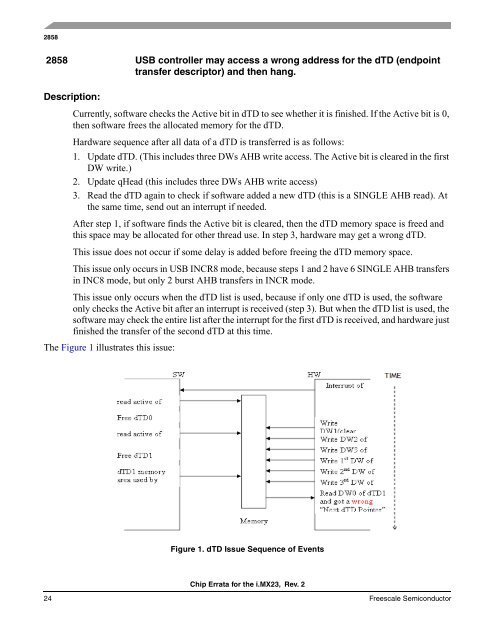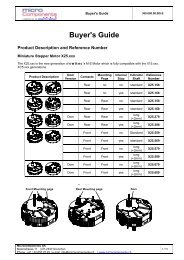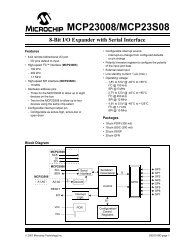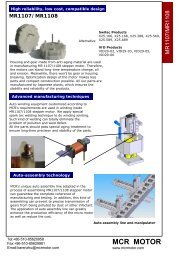Chip Errata for the i.MX23 - Guy Carpenter
Chip Errata for the i.MX23 - Guy Carpenter
Chip Errata for the i.MX23 - Guy Carpenter
Create successful ePaper yourself
Turn your PDF publications into a flip-book with our unique Google optimized e-Paper software.
2858<br />
2858 USB controller may access a wrong address <strong>for</strong> <strong>the</strong> dTD (endpoint<br />
transfer descriptor) and <strong>the</strong>n hang.<br />
Description:<br />
Currently, software checks <strong>the</strong> Active bit in dTD to see whe<strong>the</strong>r it is finished. If <strong>the</strong> Active bit is 0,<br />
<strong>the</strong>n software frees <strong>the</strong> allocated memory <strong>for</strong> <strong>the</strong> dTD.<br />
Hardware sequence after all data of a dTD is transferred is as follows:<br />
1. Update dTD. (This includes three DWs AHB write access. The Active bit is cleared in <strong>the</strong> first<br />
DW write.)<br />
2. Update qHead (this includes three DWs AHB write access)<br />
3. Read <strong>the</strong> dTD again to check if software added a new dTD (this is a SINGLE AHB read). At<br />
<strong>the</strong> same time, send out an interrupt if needed.<br />
After step 1, if software finds <strong>the</strong> Active bit is cleared, <strong>the</strong>n <strong>the</strong> dTD memory space is freed and<br />
this space may be allocated <strong>for</strong> o<strong>the</strong>r thread use. In step 3, hardware may get a wrong dTD.<br />
This issue does not occur if some delay is added be<strong>for</strong>e freeing <strong>the</strong> dTD memory space.<br />
This issue only occurs in USB INCR8 mode, because steps 1 and 2 have 6 SINGLE AHB transfers<br />
in INC8 mode, but only 2 burst AHB transfers in INCR mode.<br />
This issue only occurs when <strong>the</strong> dTD list is used, because if only one dTD is used, <strong>the</strong> software<br />
only checks <strong>the</strong> Active bit after an interrupt is received (step 3). But when <strong>the</strong> dTD list is used, <strong>the</strong><br />
software may check <strong>the</strong> entire list after <strong>the</strong> interrupt <strong>for</strong> <strong>the</strong> first dTD is received, and hardware just<br />
finished <strong>the</strong> transfer of <strong>the</strong> second dTD at this time.<br />
The Figure 1 illustrates this issue:<br />
Figure 1. dTD Issue Sequence of Events<br />
<strong>Chip</strong> <strong>Errata</strong> <strong>for</strong> <strong>the</strong> i.<strong>MX23</strong>, Rev. 2<br />
24 Freescale Semiconductor















